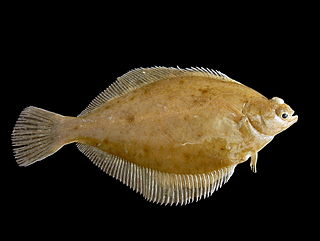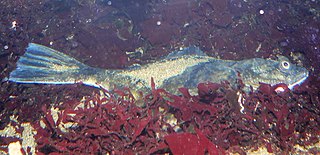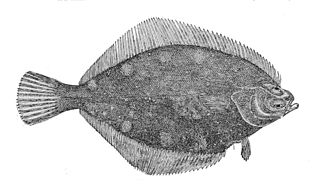
Overfishing is the removal of a species of fish from a body of water at a rate greater than that the species can replenish its population naturally, resulting in the species becoming increasingly underpopulated in that area. Overfishing can occur in water bodies of any sizes, such as ponds, wetlands, rivers, lakes or oceans, and can result in resource depletion, reduced biological growth rates and low biomass levels. Sustained overfishing can lead to critical depensation, where the fish population is no longer able to sustain itself. Some forms of overfishing, such as the overfishing of sharks, has led to the upset of entire marine ecosystems. Types of overfishing include growth overfishing, recruitment overfishing, and ecosystem overfishing.

Pleuronectidae, also known as righteye flounders, are a family of flounders. They are called "righteye flounders" because most species lie on the sea bottom on their left sides, with both eyes on their right sides. The Paralichthyidae are the opposite, with their eyes on the left side. A small number of species in Pleuronectidae can also have their eyes on the left side, notably the members of the genus Platichthys.

The European plaice, commonly referred to as simply plaice, is a species of marine flatfish in the genus Pleuronectes of the family Pleuronectidae.

Demersal fish, also known as groundfish, live and feed on or near the bottom of seas or lakes. They occupy the sea floors and lake beds, which usually consist of mud, sand, gravel or rocks. In coastal waters, they are found on or near the continental shelf, and in deep waters, they are found on or near the continental slope or along the continental rise. They are not generally found in the deepest waters, such as abyssal depths or on the abyssal plain, but they can be found around seamounts and islands. The word demersal comes from the Latin demergere, which means to sink.

The common dab is an edible flatfish of the family Pleuronectidae. It is a demersal fish native to shallow seas around Northern Europe, in particular the North Sea, where it lives on sandy bottoms down to depths of about 100 metres (330 ft). It can reach 40 centimetres (16 in) in length and can weigh up to 1 kilogram (2.2 lb), though most specimens grow no longer than 20 centimetres (7.9 in).

The witch, known in English by a variety of other common names including the witch flounder, pole flounder, craig fluke, Torbay sole, and grey sole, is a species of flatfish from the family Pleuronectidae. It occurs on both sides of the North Atlantic Ocean on muddy sea beds in quite deep water. In northern Europe it has some importance in fisheries as a food fish.

The American plaice, American sole or long rough dab is a North Atlantic flatfish that belongs, along with other right-eyed flounders, to the family Pleuronectidae. In the northwest Atlantic it ranges from Greenland and Labrador to Rhode Island, and in the northeast Atlantic it ranges from Murmansk to the English Channel, Ireland and Iceland. They live on soft bottoms at depths of 10 to 3,000 m (33–9,843 ft), but mainly between 90 and 250 m (300–820 ft).

The Greenland halibut or Greenland turbot belongs to the family Pleuronectidae, and is the only species of the genus Reinhardtius. It is a predatory fish that mostly ranges at depths between 500 and 1,000 m (1,600–3,300 ft), and is found in the cold northern Atlantic, northern Pacific, and Arctic Oceans.

The yellowtail flounder, also known as the rusty dab, is a species of flatfish in the family Pleuronectidae. Reaching 56 cm (22 in) in length, it has reddish brown upperparts, pale underparts and yellow fins. Both its eyes are on the right (upper) side of its body. Found in the western North Atlantic, it has been fished commercially by North American fisheries for food. A victim of overfishing, the yellowtail flounder is categorized as "Vulnerable" by the International Union for Conservation of Nature.

Pleuronectes is a genus of righteye flounders found in the northern oceans.

Alaska plaice is a saltwater fish that live in the North Pacific Ocean. Alaska plaice are right-eye flounders which live on the sandy bottoms of the continental shelf, up to 600 metres deep. Their geographic range is from the Gulf of Alaska in the east, to the Chukchi Sea in the north, to the Sea of Japan in the west. Alaska plaice feed mostly on polychaetes, but also eat amphipods and echiurans.

The European flounder is a flatfish of European coastal waters from the White Sea in the north to the Mediterranean and the Black Sea in the south. It has been introduced into the United States and Canada accidentally through transport in ballast water. It is caught and used for human consumption.

Fishing in the North Sea is concentrated in the southern part of the coastal waters. The main method of fishing is trawling.

English sole is a species of flatfish in the family Pleuronectidae. It is a demersal fish that lives on sandy and muddy bottoms in estuaries and near shore areas, at depths of up to 550 metres (1,800 ft). It reaches up to 57 centimetres (22 in) in length, and can weigh up to 1.5 kilograms (3.3 lb). Its native habitat is the eastern Pacific, stretching from the coast of Baja California in the south to the Bering Sea in the north.

The Petrale sole is an edible flatfish of the family Pleuronectidae. It is a demersal fish that lives on sandy bottoms, usually in deep water, down to depths of about 550 metres (1,800 ft). Males can grow to 53 centimetres (21 in) in length, females to 70 centimetres (28 in), and they can weigh up to 3.7 kilograms (8.2 lb). Its native habitat is the Eastern Pacific, stretching from the coast of Baja California in the south to the Aleutian Islands in the Bering Sea in the north.
The flathead flounder is a flatfish of the family Pleuronectidae. It is a demersal fish that lives on bottoms in shallow coastal waters, at depths of between 10 and 600 metres. Its native habitat is the northwestern Pacific, particularly the seas of Japan and Okhotsk, and the coastlines of Kamchatka and Korea. It grows up to 45 centimetres (18 in) in length.

The flathead sole is a flatfish of the family Pleuronectidae. It is a demersal fish that lives on soft, silty or muddy bottoms at depths of up to 1,050 metres (3,440 ft). Its native habitat is the northern Pacific, from the seas of Japan and Okhotsk, across the Bering Sea and to the coast of North America, as far south as Point Reyes, United States. It grows to 52 centimetres (20 in) in length, and can weigh up to 1.56 kilograms (3.4 lb); females are typically larger than males. Lifespan is at least 27 years for females and at least 30 years for males.

The rock sole, also known as the Pacific rock sole or Southern rock sole is a flatfish of the family Pleuronectidae. It is a demersal fish that lives on sand and gravel bottoms at depths of up to 575 metres (1,886 ft), though it is most commonly found between 0 and 183 metres. Its native habitat is the temperate waters of the northern Pacific, from Baja California to Alaska, the Aleutian Islands and southeastern parts of the Bering Sea. It grows up to 60 centimetres (24 in) in length and can weigh up to 1.8 kilograms (4.0 lb), and has a maximum recorded lifespan of 22 years.

The yellowfin sole is a flatfish of the family Pleuronectidae. It is a demersal fish that lives on soft, sandy bottoms at depths of up to 700 metres (2,300 ft), though it is most commonly found at depths of around 91 metres (299 ft). Its native habitat is the temperate waters of the northern Pacific, from Korea and the Sea of Japan to the Sea of Okhotsk, the Bering Sea and Barkley Sound on the west coast of Canada. Males grow up to 49 cm (19 in) in length, though the common length is around 33.5 cm (13.2 in). The maximum recorded weight is 1.7 kg (3.7 lb), and the maximum recorded lifespan is 26 years.

RV Huxley was the first research vessel used by the Marine Biological Association of the United Kingdom explicitly for fisheries research and is regarded as the first vessel yielding data for the Ministry of Agriculture, Fisheries and Food - Directorate of Fisheries, now known as the Centre for Environment, Fisheries and Aquaculture Science (Cefas).





























